翻译课堂--翻译标准
- 格式:ppt
- 大小:133.00 KB
- 文档页数:15
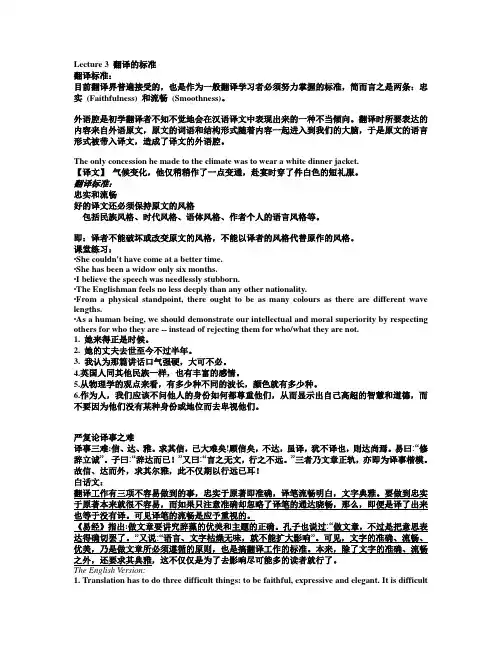
Lecture 3 翻译的标准翻译标准:目前翻译界普遍接受的,也是作为一般翻译学习者必须努力掌握的标准,简而言之是两条:忠实(Faithfulness) 和流畅(Smoothness)。
外语腔是初学翻译者不知不觉地会在汉语译文中表现出来的一种不当倾向。
翻译时所要表达的内容来自外语原文,原文的词语和结构形式随着内容一起进入到我们的大脑,于是原文的语言形式被带入译文,造成了译文的外语腔。
The only concession he made to the climate was to wear a white dinner jacket.【译文】气候变化,他仅稍稍作了一点变通,赴宴时穿了件白色的短礼服。
翻译标准:忠实和流畅好的译文还必须保持原文的风格包括民族风格、时代风格、语体风格、作者个人的语言风格等。
即:译者不能破坏或改变原文的风格,不能以译者的风格代替原作的风格。
课堂练习:•She couldn't have come at a better time.•She has been a widow only six months.•I believe the speech was needlessly stubborn.•The Englishman feels no less deeply than any other nationality.•From a physical standpoint, there ought to be as many colours as there are different wave lengths.•As a human being, we should demonstrate our intellectual and moral superiority by respecting others for who they are -- instead of rejecting them for who/what they are not.1. 她来得正是时候。

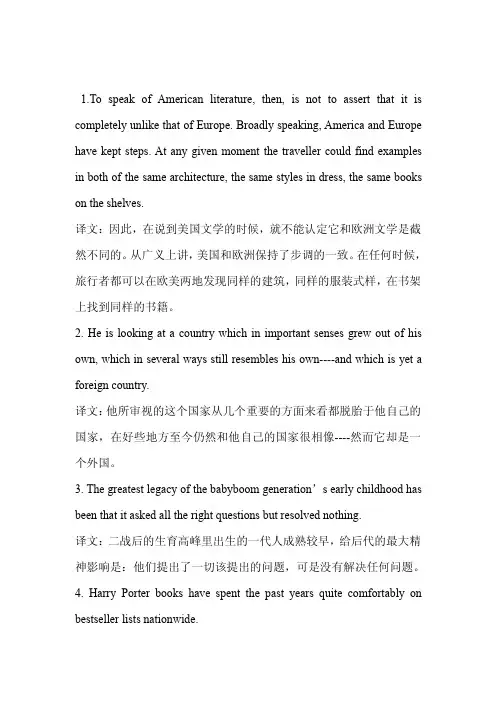
1.To speak of American literature,then,is not to assert that it is completely unlike that of Europe.Broadly speaking,America and Europe have kept steps.At any given moment the traveller could find examples in both of the same architecture,the same styles in dress,the same books on the shelves.译文:因此,在说到美国文学的时候,就不能认定它和欧洲文学是截然不同的。
从广义上讲,美国和欧洲保持了步调的一致。
在任何时候,旅行者都可以在欧美两地发现同样的建筑,同样的服装式样,在书架上找到同样的书籍。
2.He is looking at a country which in important senses grew out of his own,which in several ways still resembles his own----and which is yet a foreign country.译文:他所审视的这个国家从几个重要的方面来看都脱胎于他自己的国家,在好些地方至今仍然和他自己的国家很相像----然而它却是一个外国。
3.The greatest legacy of the babyboom generation’s early childhood has been that it asked all the right questions but resolved nothing.译文:二战后的生育高峰里出生的一代人成熟较早,给后代的最大精神影响是:他们提出了一切该提出的问题,可是没有解决任何问题。
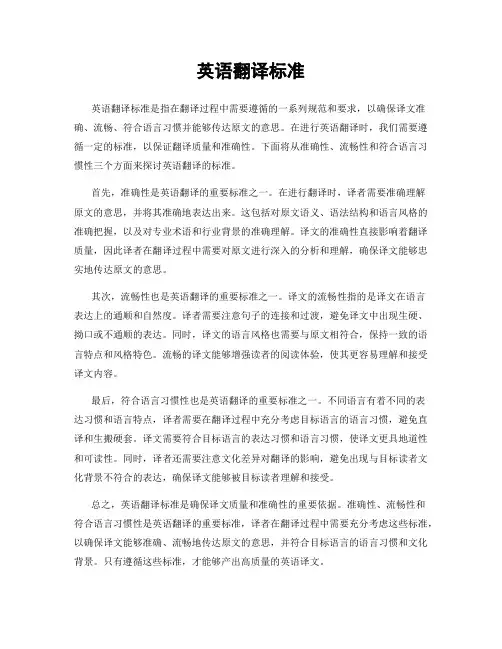
英语翻译标准英语翻译标准是指在翻译过程中需要遵循的一系列规范和要求,以确保译文准确、流畅、符合语言习惯并能够传达原文的意思。
在进行英语翻译时,我们需要遵循一定的标准,以保证翻译质量和准确性。
下面将从准确性、流畅性和符合语言习惯性三个方面来探讨英语翻译的标准。
首先,准确性是英语翻译的重要标准之一。
在进行翻译时,译者需要准确理解原文的意思,并将其准确地表达出来。
这包括对原文语义、语法结构和语言风格的准确把握,以及对专业术语和行业背景的准确理解。
译文的准确性直接影响着翻译质量,因此译者在翻译过程中需要对原文进行深入的分析和理解,确保译文能够忠实地传达原文的意思。
其次,流畅性也是英语翻译的重要标准之一。
译文的流畅性指的是译文在语言表达上的通顺和自然度。
译者需要注意句子的连接和过渡,避免译文中出现生硬、拗口或不通顺的表达。
同时,译文的语言风格也需要与原文相符合,保持一致的语言特点和风格特色。
流畅的译文能够增强读者的阅读体验,使其更容易理解和接受译文内容。
最后,符合语言习惯性也是英语翻译的重要标准之一。
不同语言有着不同的表达习惯和语言特点,译者需要在翻译过程中充分考虑目标语言的语言习惯,避免直译和生搬硬套。
译文需要符合目标语言的表达习惯和语言习惯,使译文更具地道性和可读性。
同时,译者还需要注意文化差异对翻译的影响,避免出现与目标读者文化背景不符合的表达,确保译文能够被目标读者理解和接受。
总之,英语翻译标准是确保译文质量和准确性的重要依据。
准确性、流畅性和符合语言习惯性是英语翻译的重要标准,译者在翻译过程中需要充分考虑这些标准,以确保译文能够准确、流畅地传达原文的意思,并符合目标语言的语言习惯和文化背景。
只有遵循这些标准,才能够产出高质量的英语译文。
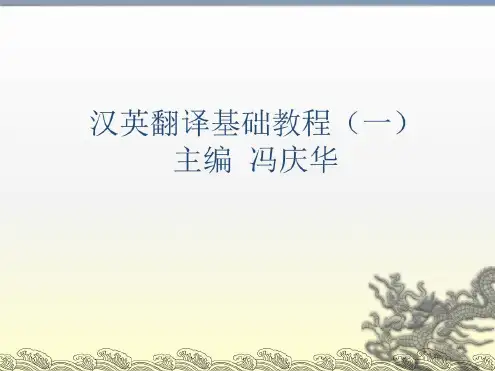
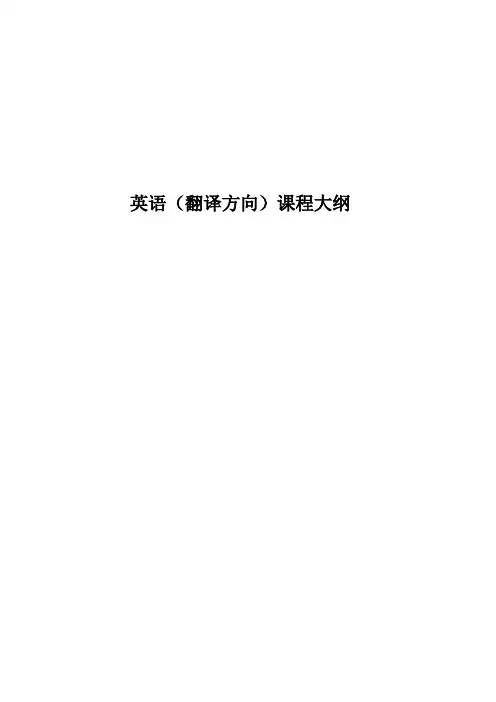
英语(翻译方向)课程大纲目录1.基础英语(Ⅰ、Ⅱ、Ⅲ、Ⅳ)Basic English(Ⅰ、Ⅱ、Ⅲ、Ⅳ)2.高级英语(Ⅰ、Ⅱ)Advanced English(Ⅰ、Ⅱ)3.语音English Pronunciation and Intonation4.听力(Ⅰ、Ⅱ、Ⅲ、Ⅳ)Listening(Ⅰ、Ⅱ、Ⅲ、Ⅳ)5.口语(Ⅰ、Ⅱ、Ⅲ、Ⅳ)Oral English(Ⅰ、Ⅱ、Ⅲ、Ⅳ)6.阅读(Ⅰ、Ⅱ、Ⅲ、Ⅳ)Reading(Ⅰ、Ⅱ、Ⅲ、Ⅳ)7.写作(Ⅰ、Ⅱ、Ⅲ、Ⅳ)Writing(Ⅰ、Ⅱ、Ⅲ、Ⅳ)8.语法(Ⅰ、Ⅱ)Grammar(Ⅰ、Ⅱ)9.交替传译(Ⅰ、Ⅱ、III)Consecutive Interpretation(Ⅰ、Ⅱ、III)10.翻译理论Translation Theory11.英汉翻译English-Chinese Translation12.汉英翻译Chinese-English Translation13.英语视听说Audio-visual-oral English14.语言学导论An Introduction to Linguistics15.英国文学(Ⅰ、Ⅱ)British Literature(Ⅰ、Ⅱ)16.美国文学(Ⅰ、Ⅱ)American Literature(Ⅰ、Ⅱ)17.学术论文写作Academic Thesis Writing18.英美概况An Introduction to Britain and America19.英语词汇学English Lexicology20.英语报刊选读Selected Readings of English Newspapers and Magazines21.文体与翻译Stylistics and Translation22.修辞与翻译Rhetorics and Translation23.同声传译Simultaneous Interpretation24.汉英对比概论An Introduction to Comparative Studies between Chinese andEnglish25.中西文化比较Comparative Studies of Chinese and Western Cultures26.翻译欣赏与批评Translation Criticism and Appreciation27.科技翻译Science Translation28.法律翻译Legal Translation29.视译Sight Translation30.语用与翻译Pragmatics & Translation31.影视翻译Film and TV Translation32.商务翻译Commercial Translation33.日语Japanese基础英语(Basic English)基础英语是英语专业学生基础阶段的一门主干课程。
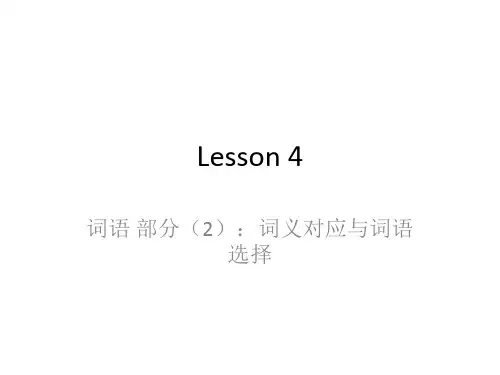
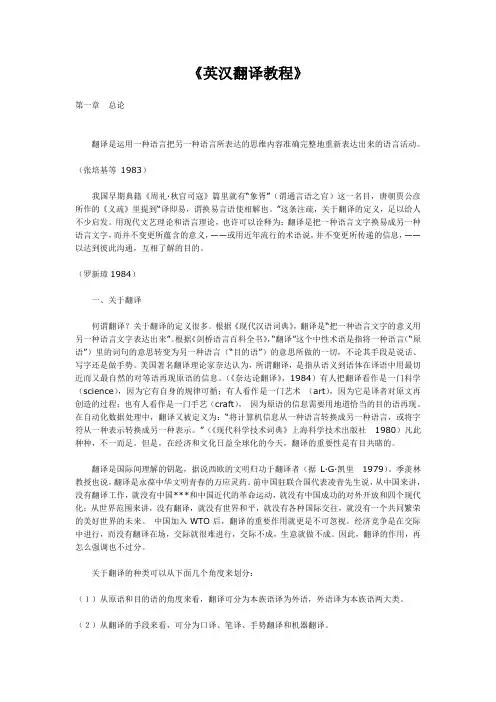
《英汉翻译教程》第一章总论翻译是运用一种语言把另一种语言所表达的思维内容准确完整地重新表达出来的语言活动。
(张培基等1983)我国早期典籍《周礼·秋官司寇》篇里就有“象胥”(谓通言语之官)这一名目,唐朝贾公彦所作的《义疏》里提到“译即易,谓换易言语使相解也。
”这条注疏,关于翻译的定义,足以给人不少启发。
用现代文艺理论和语言理论,也许可以诠释为:翻译是把一种语言文字换易成另一种语言文字,而并不变更所蕴含的意义,——或用近年流行的术语说,并不变更所传递的信息,——以达到彼此沟通,互相了解的目的。
(罗新璋1984)一、关于翻译何谓翻译?关于翻译的定义很多。
根据《现代汉语词典》,翻译是“把一种语言文字的意义用另一种语言文字表达出来”。
根据《剑桥语言百科全书》,“翻译”这个中性术语是指将一种语言(“原语”)里的词句的意思转变为另一种语言(“目的语”)的意思所做的一切,不论其手段是说话、写字还是做手势。
美国著名翻译理论家奈达认为,所谓翻译,是指从语义到语体在译语中用最切近而又最自然的对等语再现原语的信息。
(《奈达论翻译》,1984)有人把翻译看作是一门科学(science),因为它有自身的规律可循;有人看作是一门艺术(art),因为它是译者对原文再创造的过程;也有人看作是一门手艺(craft),因为原语的信息需要用地道恰当的目的语再现。
在自动化数据处理中,翻译又被定义为:“将计算机信息从一种语言转换成另一种语言,或将字符从一种表示转换成另一种表示。
”(《现代科学技术词典》上海科学技术出版社1980)凡此种种,不一而足。
但是,在经济和文化日益全球化的今天,翻译的重要性是有目共睹的。
翻译是国际间理解的钥匙,据说西欧的文明归功于翻译者(据L·G·凯里1979)。
季羡林教授也说,翻译是永葆中华文明青春的万应灵药。
前中国驻联合国代表凌青先生说,从中国来讲,没有翻译工作,就没有中国***和中国近代的革命运动,就没有中国成功的对外开放和四个现代化;从世界范围来讲,没有翻译,就没有世界和平,就没有各种国际交往,就没有一个共同繁荣的美好世界的未来。
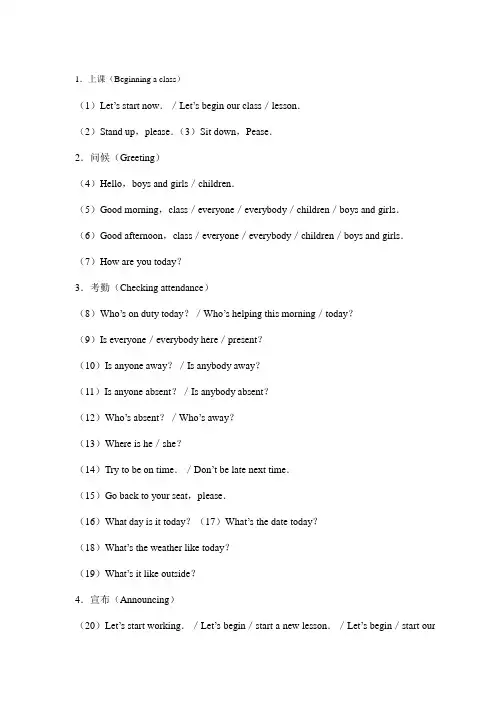
1.上课(Beginning a class)(1)Let’s start now./Let’s begin our class/lesson.(2)Stand up,please.(3)Sit down,Pease.2.问候(Greeting)(4)Hello,boys and girls/children.(5)Good morning,class/everyone/everybody/children/boys and girls.(6)Good afternoon,class/everyone/everybody/children/boys and girls.(7)How are you today?3.考勤(Checking attendance)(8)Who’s on duty today?/Who’s helping this morning/today?(9)Is everyone/everybody here/present?(10)Is anyone away?/Is anybody away?(11)Is anyone absent?/Is anybody absent?(12)Who’s absent?/Who’s away?(13)Where is he/she?(14)Try to be on time./Don’t be late next time.(15)Go back to your seat,please.(16)What day is it today?(17)What’s the date today?(18)What’s the weather like today?(19)What’s it like outside?4.宣布(Announcing)(20)Let’s start working./Let’s begin/start a new lesson./Let’s begin/start ourlesson.(21)First,let’s review/do some review.(22)What did we learn In the last lesson?(23)Who can tell/remember what we did In the last lesson/yesterday?(24)Now we’re going to do something new/different./Now let’s learn something new.(25)We have some now words/sentences.5.提起注意(Directing attention)(26)Ready?/Are you ready?(27)Did you get there?/Do you understand?(28)Is that clear?(29)Any volunteers?30)Do you know what to do?(31)Be quiet,please./Quiet,please.(32)Listen,please.(33)Listen carefully,please.(34)Listen to the tape recorder/the recording.(35)Look carefully,please.(36)Look over here.(37)Watch carefully.(38)Are your watching?(39)Please look at the black-board/picture/map…(40)Pay attention to your spelling/pronunciation.6.课堂活动(Classroom activities)(41)Start!/Start now.(42)Everybody together./All together.(43)Practise in a group./Practise In groups/In groups,please.(44)Get into groups of three/four…(45)Every body find a partner/friend.46)In pairs,please.(47)One at a time./Let’s do It one by one.(48)Now you,please./Your turn(Students name).(49)Next,please.Now you do the same,please.(50)Let’s act./Let’s act out/do the dialogue.(51)Who wants to be A?(52)Practise the dialogue,please.(53)Now Tom will be A,and the other half will be B.(54)Please take(play)the part of…(55)Whose turn is It?(56)It’s your turn. (57)Wait your turn,please.(58)Stand inline./Line up.(59)One by one./One at a time,please.(60)In twos./In pairs.(61)Don’t speak out.(62)Turn around.7.请求(Request)(63)Could you please try It again?(64)Could you please try the next one?(65)Will you please help me?8.鼓励(Encouraging)(66)Can you try?(67)Try,please.(68)Try your best./Do your best.(69)Think it over and try again.(70)Don’t be afraid/shy.9.指令(Issuing a command)(7)Say/Read after me,please.(72)Follow me,please.(73)Do what do.(7)Repeat,please./Repeat after me.(75)Once more,please./One more time,please.(7)Come here,please.(77)Please come to the front./Come up and write on the blackboard/chalkboard.(78)Come and write It on the blackboard.(79)Please go back to your seat.(80)In English,please.(81)Put your hand up,please.Raise your hand,please.(82)Put your hands down,please./Hands down,please.(83)Say it/Write it in Chinese/English.(84)Please take out your books.(85)Please open your books at page…/Find page…/Turn to Page…(86)Please answer the question/questions./Please answer my qllllst1On(s).(87)Please read this letter/word/sentence out loud./Please readout this letter/word/sentence.(88)Please stop now./Stop now,please./Stop here,please.(89)Clean up your desk/the classroom,please.(90)It’s clean-up time./Tidy up your desk/the classroom.(91)Put your things away./Clean off your desk./Pick up the scraps·(92)Clean the blackboard.(93)Plug in the tape-recorder,please.(94)Put the tape-recorder away.(95)Put the tap,In it’s box/cassette.(96)Listen and repeat.(97)Look and listen.(98)Repeat after me.(99)Follow the words.(100)Fast./Quickly!/Be quick,please.(101)Hurry!/Hurry up,please.(102)Slow down,please.(10)Slowly.(104)Bring me some chalk,please.10.禁止和警告(Prohibition and warning)(105)Stop talking./Stop talking now,please.(106)Don’t talk./Everybody quiet,please.(107)Don’t be silly.(108)Settle down.11.评价(109)Good,thank you.(10)Good/Very good./God job./Good work./Good example.(111)A good answer./Nice work.(112)Excellent./Great!/Well done./Very good./I like the way you(13)That’s Interesting(114)Don’t worry about It./No problem.(115)OK!/That’s OK.(116)I don’t think so.(117)That’s not quite right,any other answers?/That’s close/That’s almost right.(118)Not quite,can anyone help him/her?/try again.(119)A good try.12.布置作业(Setting homework)(120)For today’s homework…(121)Practise after class./Practise at home.(122)Say it out loud,before you write It down.(123)Copy/Print/Write each word twice.(124)Remember(Memorize)these words/sentences.(125)Learn these words/these sentences/this text by heart.(126)Do your homework./Do the next lesson./Do the new work.13.下课(Dismissing the class)(127)Hand in your workbooks,please.(128)Time is up.(129)The bell is ringing.(130)There’s the bell.(131)There goes the bell.(132)Let’s stop here.(133)That’s all for today.(134)Class is over.(135)Good bye./Bye./See you next time.。
![中级口译翻译教程(英翻中)[1].](https://uimg.taocdn.com/b00da9e004a1b0717ed5dd05.webp)
Unit 1【例1】The history of a tree from the time it starts in the forest until the boards which it yields are used, would form an interesting and, in many instances, an exciting story.(“×”号表示译文有问题,下同)×树的历史开始于森林中,直到生产为木板后被使用为止,成为一个有趣且有许多事例的激动人心的故事。
上面这句话的原文实际上主要说了两点内容:1、树的历史的起迄时间2、树的历史是怎样一回事【译文】一棵树,从它在森林中生长起直到被制成木板使用为止,这段历史会构成一个饶有趣味的故事,在很多情况下这个故事十分激动人心。
例2】There are two regulatory systems which interact. One timing system comes from the evidence of our senses and stomachs, and the periodicity we experience when living in a particular time zone.×有两个调节系统相互作用。
一个定时系统来自于我们的感官和胃的证明,就是当我们生活在一个特定的时区所经历的周期性。
【译文】人体有两个相互作用的时间调节系统。
一个时间调节系统依据感官和胃发出的信息,依据我们生活在某个时区所体验的周期性规律。
寻找对等词语和结构然后将其串接成句的翻译方法,常表现如下:1、简单语句的译文虽然生硬,但基本可读。
如:【例3】I can see three different 无效s of composers in musical history, each of whom creates music in a somewhat different fashion.×我能看到音乐史上有三种不同的作曲家,他们中每一个人以某种不同的方式创作音乐。
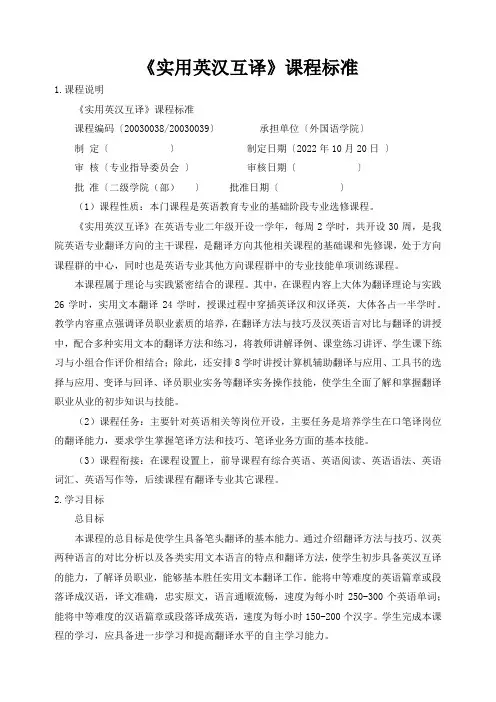
《实用英汉互译》课程标准1.课程说明《实用英汉互译》课程标准课程编码〔20030038/20030039〕承担单位〔外国语学院〕制定〔〕制定日期〔2022年10月20日〕审核〔专业指导委员会〕审核日期〔〕批准〔二级学院(部)〕批准日期〔〕(1)课程性质:本门课程是英语教育专业的基础阶段专业选修课程。
《实用英汉互译》在英语专业二年级开设一学年,每周2学时,共开设30周,是我院英语专业翻译方向的主干课程,是翻译方向其他相关课程的基础课和先修课,处于方向课程群的中心,同时也是英语专业其他方向课程群中的专业技能单项训练课程。
本课程属于理论与实践紧密结合的课程。
其中,在课程内容上大体为翻译理论与实践26学时,实用文本翻译24学时,授课过程中穿插英译汉和汉译英,大体各占一半学时。
教学内容重点强调译员职业素质的培养,在翻译方法与技巧及汉英语言对比与翻译的讲授中,配合多种实用文本的翻译方法和练习,将教师讲解译例、课堂练习讲评、学生课下练习与小组合作评价相结合;除此,还安排8学时讲授计算机辅助翻译与应用、工具书的选择与应用、变译与回译、译员职业实务等翻译实务操作技能,使学生全面了解和掌握翻译职业从业的初步知识与技能。
(2)课程任务:主要针对英语相关等岗位开设,主要任务是培养学生在口笔译岗位的翻译能力,要求学生掌握笔译方法和技巧、笔译业务方面的基本技能。
(3)课程衔接:在课程设置上,前导课程有综合英语、英语阅读、英语语法、英语词汇、英语写作等,后续课程有翻译专业其它课程。
2.学习目标总目标本课程的总目标是使学生具备笔头翻译的基本能力。
通过介绍翻译方法与技巧、汉英两种语言的对比分析以及各类实用文本语言的特点和翻译方法,使学生初步具备英汉互译的能力,了解译员职业,能够基本胜任实用文本翻译工作。
能将中等难度的英语篇章或段落译成汉语,译文准确,忠实原文,语言通顺流畅,速度为每小时250-300个英语单词;能将中等难度的汉语篇章或段落译成英语,速度为每小时150-200个汉字。
第一章概述第一节翻译的定义与种类1 翻译的定义不同的学者可能会从不同的角度对翻译进行阐释,所以,他们对翻译的定义也不一样。
例如,“翻译是用一种语言形式把另一种语言形式里的内容重新表现出来的语言实践活动”(冯庆华);“翻译是把一种语言文字的意义用另一种语言文字表达出来”(赵桂华);“翻译是指如何将某一语言活动的言语产物转换到另一种语言中去”(叶子南);等等。
另外,中外学者对翻译的定义也有小小的差别。
例如,奈达(2004)将翻译定义为“翻译就是在译入语中用最贴近的自然的对等语把原语中的信息复制过来,首先是在含义方面,其次是文体风格”(Translation consists in reproducing in the receptor language the closest natural equivalent of the source-language message, first in terms of meaning and secondly in terms of style.);另一个翻译理论大家纽玛克(2001)对翻译定义的阐述是“翻译就是把一个文本的意义按原作者所意想的方式译入到另一种语言”(Translation is rendering the meaning of a text into another language in the way that the author intended the text.)。
事实上,不同的翻译学派对翻译的定义也不一样:文艺学派认为翻译是作品文体风格的转换,是译者的再创作;语言学派认为翻译是两种语言的话语转换;交际学派认为翻译是信息的交换;社会符号学派则认为翻译是社会文化的转换;等等。
从译者的立场出发,我们认为翻译就是把原语话语变为另一种语言话语的活动,是把原语作者的意图,不论是语言的还是非语言的,用另一种语言传递给读者。
这也是翻译的本质所在。